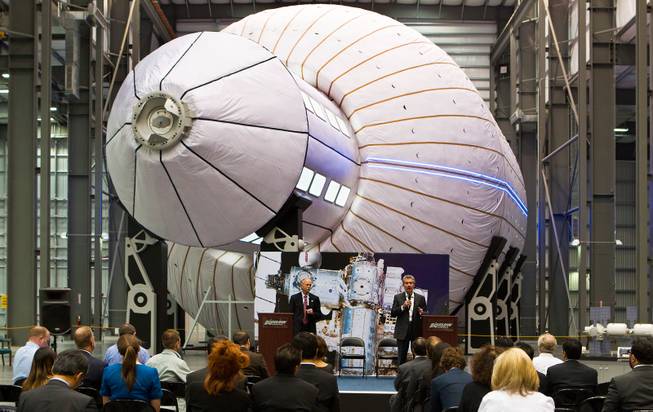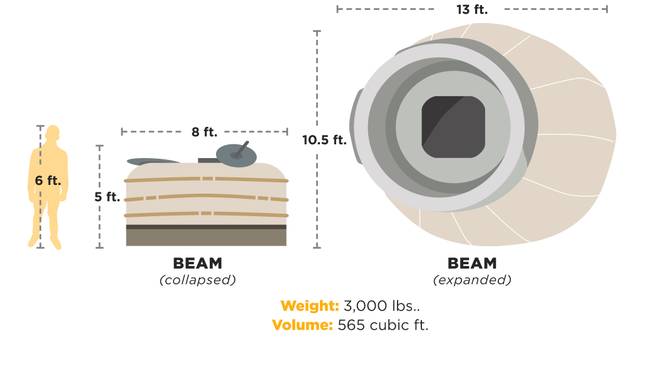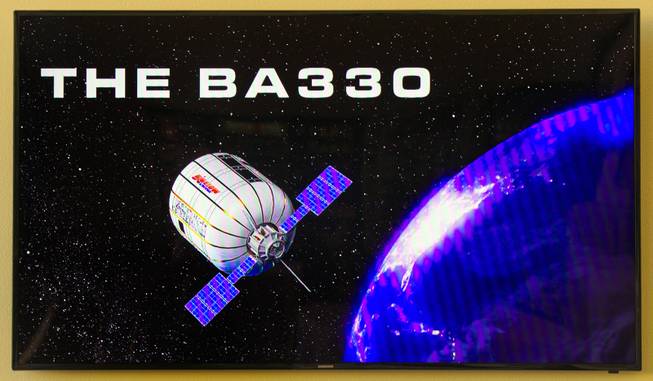New Mars Forums
You are not logged in.
- Topics: Active | Unanswered
Announcement
Pages: 1
#1 2015-05-18 19:08:47
- SpaceNut
- Administrator
- From: New Hampshire
- Registered: 2004-07-22
- Posts: 29,861
Bigelow's BEAM
Here are some of the topics to which we have meantioned the inflateables within.
http://www.newmars.com/forums/viewtopic.php?id=5594&p=3
http://www.newmars.com/forums/viewtopic.php?id=6156&p=4
http://www.newmars.com/forums/viewtopic.php?id=7025
http://www.newmars.com/forums/viewtopic.php?pid=120952
http://www.newmars.com/forums/viewtopic.php?pid=122815
BEAM: A space habitat created in North Las Vegas

Robert Bigelow speaks during the Bigelow Aerospace introduction of their B.E.A.M. (Bigelow Expandable Activity Module) on Thursday, March, 12, 2015. He is the company founder and joined by William Gerstenmaier as NASA’s Associate Administrator for Human Exploraton and Operations. L.E. Baskow
Houston may be home to the U.S. space program, but out-of-this-world innovations also are being created right here in Southern Nevada.
NASA officials recently visited Bigelow Aerospace’s sprawling 50-acre campus in North Las Vegas to view the completed Bigelow Expandable Activity Module, or BEAM, a $17.8 million space habitat billionaire Robert Bigelow and his team invented for the federal government.
A larger and more nimble alternative to traditional thick, rigid space structures, BEAM is an inflatable room that can collapse and expand in space. It will be attached to the International Space Station this fall and will remain in place for two years while scientists and other crew test its usability.
What is it?
BEAM is an expandable space habitat that, when inflated, serves as a self-contained room for astronauts. It is the first flexible, nonmetallic structure to be tested in space. It is about the size of a large family camping tent, resembles a thick, steel-belted tire and inside looks like a large closet with white padded walls and assorted sensors and equipment.
Made partially from variants of Kevlar, used in bulletproof vests, BEAM is lighter and smaller than other space habitats. The main component that gives the module its compact, expandable structure is several layers of Vectran, a synthetic, heat-resistant fiber twice as a strong as Kevlar and commonly used to reinforce ropes and cables. NASA uses Vectran in spacesuits and as airbags on several Mars lander systems.
How it works
The BEAM will be trucked to Florida, then launched as early as September from Cape Canaveral Air Force station aboard a robotic SpaceX Dragon cargo capsule. Once the SpaceX reaches the International space station, astronauts will deploy the station’s robotic arm and affix BEAM to a docking port on the Space Station’s Tranquility node, a process called berthing.
Once BEAM is attached, astronauts will activate a pressurization system that will expand BEAM with air stored inside the module. BEAM also can be inflated using pressure from the space station. The inflation process takes about four and a half minutes
How it will be used
What exactly BEAM will be used for during its two-year stay remains up for discussion. NASA officials have suggested crew members will enter the room several times a year to collect data. The hatch would remain closed the rest of the time.
Using the module will be less important than testing its integrity and demonstrating how it holds up to space conditions. BEAM will be monitored for leaks, temperature changes and responses to radiation from varying positions in relation to the sun. Acoustics and resistance to debris also will be tracked.
What could BEAM be used for?
Inflatable modules are an important step toward developing deep-space habitats that support NASA’s plans for extended human space flight, particularly the goal of sending a manned mission to Mars. If BEAM’s mission is successful, it could open the door to developing larger modules as free-floating space stations or, as some BEAM executives have hinted, using future habitats to support developments on the moon.
In the short term, expandable habitats can be used as extra space for testing, research and storage aboard existing structures such as the International Space Station. BEAMs can be tailored to specific activities and missions, and can be connected to create larger structures. They also may be used in orbit for commercial purposes such as research, warehousing and manufacturing for pharmaceutical companies, automakers and space engineering firms, whose work could benefit from the module’s weightless environment.
BEAM also is being touted for its potential to offer stronger protection than its predecessors against radiation and physical debris such as micrometeoroids. The layers of Vectran give the structure flexible walls believed to be able to sustain impact from debris far better than the rigid walls of current modules. Ground lab testing found that micrometeoroids that normally would puncture the International Space Station only made it about halfway through BEAM’s skin.
The history
The concept of inflatable space habitats dates to the 1960s but gained steam in the 1990s with a module called TransHab. The inflatable module was proposed as a crew quarters for the International Space Station and was tested, but NASA canceled the program in 2000.
Bigelow Aerospace licensed the technology from NASA and continued to develop the module, launching prototypes into orbit in 2006 and 2007. NASA took a second look at the technology in 2010 and contracted Bigelow in December 2012.
What’s next for Bigelow?
BEAM is a scaled-down version of Bigelow’s BA330 system, which the company is in the midst of developing. The BA330 will be larger, with 11,664 cubic feet of space and able to support a crew of up to six.
Even larger modules, such as the 79,458-cubic-foot Olympus — twice the size of the International Space Station — also are in the works.
The scaled-up versions will be marketed as stand-alone commercial space stations for research organizations, corporations and governments. Bigelow said two 330 modules could be shipped by the end of 2017 and deployed in 2018.
Offline
Like button can go here
#2 2016-01-13 19:03:07
- SpaceNut
- Administrator
- From: New Hampshire
- Registered: 2004-07-22
- Posts: 29,861
Re: Bigelow's BEAM
From ISS topic:
I was reminded of a Bigelow Inflateable when I was searching for data for another topic...
Inside NASA's Deal for an Inflatable Space Station Room posted back in January 16, 2013....
NASA will pay $17.8 million to Bigelow Aerospace of North Las Vegas to build an inflatable module, test it and prep it for flight. The Bigelow Expandable Activity Module (BEAM) is to be launched around the summer of 2015, launched to the International Space Station by a Falcon 9 rocket built by another private spaceflight company, California-based SpaceX.
The module is cylindrical, weighs roughly 3,000 pounds (1,360 kilograms) and is about 13 feet (4 meters) long and 10.5 feet (3.2 m) wide
So when is there going to be an update?
Bigelow could provide a whole slew of "hab, etc" modules, based around their B-330 series. If NASA would just get on with it. Bigelow is not a favored contractor with a history dating back to 1958, though.
Any centrifuge module would have to be "from-scratch". That being the case, why not make it a free-flying spinning baton of B-330's flying alongside close by? About 17 should do it for 56 m R at 4 rpm, based on B-330 length, and also provide an enormous habitable volume, way bigger than the current ISS. Might even replace ISS as the original wears out and gets dangerous, sometime around 2025-2030. And you get to study all the partial gee levels!
Piecemeal replacement avoids congressional visibility, thus improving the probability of actually getting funds. Start with a half dozen B-330's, and just spin it faster.
GW
BEAM module waits for transportion to the ISS
Beam will serve as an experimental module designed to test the hardiness of expandable modules in space. Engineers at Bigelow packed up the unit for transportation to Florida from their Nevada headquarters in March of this year. The module was supposed to fly to ISS in September aboard SpaceX’s CRS-8 mission. However, that was before a Falcon 9 rocket, carrying the CRS-7 Dragon cargo ship bound for the outpost disintegrated during launch.
The walls consist of alternating layers of foam and a material called Nextel. These layers provide impact resistance and thermal protection as the outside temperature can vary from –200 °F (–128.9 °C) in the shade to over 250 °F (121.1 °C) in sunlight. The inner structures form an airtight bladder that contains the pressurized atmosphere. Bigelow replaced the Nextel cloth with Vectran and Kevlar during the reengineering process.
BEAM will be attached to the aft port of Tranquility sometime in early 2016.
Offline
Like button can go here
Pages: 1

